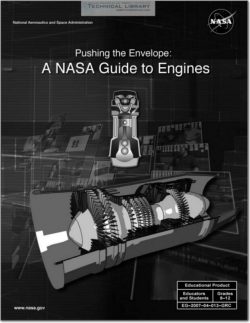NASA-EG-2007-04-013-GRC

- Version
- 114 Downloads
- 4.82 MB File Size
- 1 File Count
- August 14, 2016 Create Date
- August 14, 2016 Last Updated
Pushing the Envelope; A NASA Guide to Engines

Introduction
“What is propulsion? The word is derived from
two Latin words: pro meaning before or forwards
and pel/ere meaning to drive. Propulsion means to
push forward or drive an object forward. A propul-
sion system is a machine that produces thrust to
push an object forward. On airplanes and space-
craft, thrust is generated through some application
of Newton’s third law of action and reaction. A gas,
or working fluid, is accelerated by the engine, and
the reaction to this acceleration produces a force on
the engine.
The amount of thrust generated depends on the
mass flow through the engine and the exit veloc-
ity of the gas. Different propulsion systems generate
thrust in slightly different ways. We will discuss sev-
eral propulsion systems including the propeller, the
turbine (or jet) engine, the ramjet and scramjet, and
ion engines.
Why are there different types of engines? If we
think about Newton’s first law of motion, we real-
ize that an airplane propulsion system must serve
two purposes. First, the thrust from the propulsion
system must balance the drag of the airplane when
the airplane is cruising. And second, the thrust from
the propulsion system must exceed the drag of the
airplane for the airplane to accelerate. In fact, the
greater the difference between the thrust and the
drag, called the excess thrust, the faster the airplane
will accelerate.
Some aircraft, like airliners and cargo planes,
spend most of their life in a cruise condition. For
these airplanes, excess thrust is not as important
as high engine efficiency and low fuel usage. Since
thrust depends on both the amount of gas moved
and the velocity, we can generate high thrust by
accelerating a large mass of gas by a small amount,
or by accelerating a small mass of gas by a large
amount. Because of the aerodynamic efficiency of
propellers and fans, it is more fuel efficient to accel-
erate a large mass by a small amount. That is why
we find high-bypass fans and turboprops on cargo
planes and airliners.
Some aircraft, like fighter planes or experimental
high-speed aircraft require very high excess thrust
Pushing the Envelope: A NASA Guide to Engines
to accelerate quickly and to overcome the high drag
associated with high speeds. For these airplanes,
engine efficiency is not as important as very high
thrust. Military aircraft typically employ afterburn-
ing turbojets to gain extra thrust for short periods of
time.”*
In this educator’s guide related topics such as
pollution, air density, noise, gas laws, and Newton’s
laws as related to aircraft engines will be examined.
| File | Action |
|---|---|
| NASA-EG-2007-04-013-GRC Pushing the Envelope; A NASA Guide to Engines.pdf | Download |
Comment On This Post